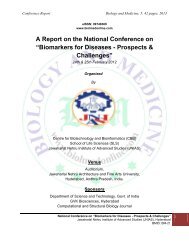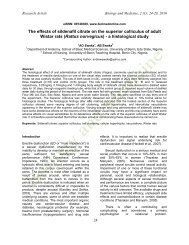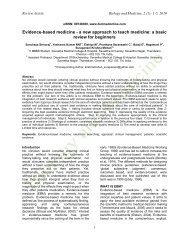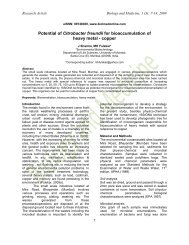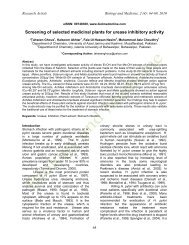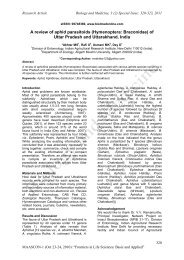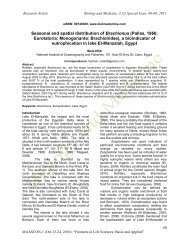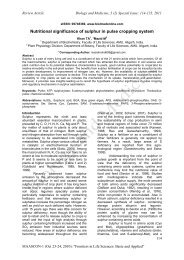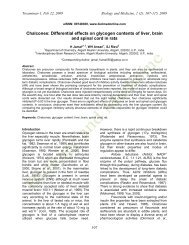Immunomodulatory effects of Tinospora cordifolia (Guduchi) on ...
Immunomodulatory effects of Tinospora cordifolia (Guduchi) on ...
Immunomodulatory effects of Tinospora cordifolia (Guduchi) on ...
Create successful ePaper yourself
Turn your PDF publications into a flip-book with our unique Google optimized e-Paper software.
Research Article Biology and Medicine, 3 (2) Special Issue: 134-140, 2011<br />
Indirect effect: E. coli were treated with<br />
macrophage supernatants collected after 24 h<br />
and 48 h treatment <str<strong>on</strong>g>of</str<strong>on</strong>g> <str<strong>on</strong>g>Guduchi</str<strong>on</strong>g> and LPS. The<br />
24 h and 48 h treated cell supernatant showed<br />
comparatively larger and clear z<strong>on</strong>e <str<strong>on</strong>g>of</str<strong>on</strong>g><br />
Drug treated cell<br />
supernatant<br />
(24h)<br />
inhibiti<strong>on</strong>. The 48 h treated cell supernatant<br />
treatment to E. coli showed larger z<strong>on</strong>e <str<strong>on</strong>g>of</str<strong>on</strong>g><br />
inhibiti<strong>on</strong> which was 1.4 cm in diameter, while<br />
the medium treated cell supernatant showed<br />
1.35 cm <str<strong>on</strong>g>of</str<strong>on</strong>g> z<strong>on</strong>e <str<strong>on</strong>g>of</str<strong>on</strong>g> inhibiti<strong>on</strong>.<br />
Fig. 4: Antibacterial susceptibility shown with the indirect effect. Effective z<strong>on</strong>e <str<strong>on</strong>g>of</str<strong>on</strong>g> inhibiti<strong>on</strong> can be<br />
observed.<br />
Discussi<strong>on</strong><br />
Macrophage activati<strong>on</strong> is being better<br />
understood with the biochemical and<br />
cytochemical assay. In actively respiring cells,<br />
superoxide and hydrogen peroxide can be<br />
activated which further generates reactive<br />
oxygen species (ROS). These ROS would<br />
cause extensive damage to DNA proteins and<br />
lipids. The drug treatment can activate the<br />
macrophages (phagosomes) which inhibit<br />
intracellular replicati<strong>on</strong> <str<strong>on</strong>g>of</str<strong>on</strong>g> the pathogens.<br />
Am<strong>on</strong>g the natural BRMs, many herbs<br />
and medicinal plants have immunopotentiating<br />
capacity and are reffered to as ‘Rasayan’ in<br />
the Ayurvedic system <str<strong>on</strong>g>of</str<strong>on</strong>g> medicine. The<br />
chlor<str<strong>on</strong>g>of</str<strong>on</strong>g>orm & benzene extracts <str<strong>on</strong>g>of</str<strong>on</strong>g> <str<strong>on</strong>g>Guduchi</str<strong>on</strong>g><br />
were found to possess significant antibacterial<br />
activity as compared with the standard.<br />
<str<strong>on</strong>g>Guduchi</str<strong>on</strong>g> leaf extract is useful in Proteus<br />
vulgaris, Staphylocosus aureus, Streptococus<br />
pyrogens, Bacilus subtilis and Escherochia coli<br />
infecti<strong>on</strong>s (Nagvalli et al., 2006). The entire<br />
plant is regarded as a valuable alterative and<br />
stimulant. It is useful in eye c<strong>on</strong>diti<strong>on</strong>s, as a<br />
Medium treated<br />
cell supernatant<br />
tissue builder, helps development <str<strong>on</strong>g>of</str<strong>on</strong>g><br />
intelligence, and retains youth by helping to<br />
prevent premature aging. In view <str<strong>on</strong>g>of</str<strong>on</strong>g> the known<br />
immunomodulatory properties <str<strong>on</strong>g>of</str<strong>on</strong>g> T. <str<strong>on</strong>g>cordifolia</str<strong>on</strong>g><br />
(Dahanukar et al., 2000), we were interested<br />
in studying the antimicrobial potential by<br />
testing inhibiti<strong>on</strong> <str<strong>on</strong>g>of</str<strong>on</strong>g> bacteria by formati<strong>on</strong> <str<strong>on</strong>g>of</str<strong>on</strong>g> a<br />
z<strong>on</strong>e around a paper disc impregnated with<br />
the drug or drug treated macrophage cell<br />
supernatant placed <strong>on</strong> a mat culture <str<strong>on</strong>g>of</str<strong>on</strong>g> E. coli.<br />
Presence <str<strong>on</strong>g>of</str<strong>on</strong>g> nitrite and lysozyme in the cell<br />
supernatant <str<strong>on</strong>g>of</str<strong>on</strong>g> activated macrophages leads<br />
to inhibiti<strong>on</strong> <str<strong>on</strong>g>of</str<strong>on</strong>g> bacterial mats.<br />
Macrophages perform a variety <str<strong>on</strong>g>of</str<strong>on</strong>g><br />
complex microbicidal functi<strong>on</strong>s, including<br />
surveillance, chemotaxis, phagocytosis and<br />
destructi<strong>on</strong> <str<strong>on</strong>g>of</str<strong>on</strong>g> targeted organisms (Beutler,<br />
2004). The spectrum <str<strong>on</strong>g>of</str<strong>on</strong>g> microorganisms kept<br />
<strong>on</strong> check by phagocytes includes fungi,<br />
bacteria and virus infected cells (Beutler,<br />
2004). Producti<strong>on</strong> <str<strong>on</strong>g>of</str<strong>on</strong>g> nitric oxide and lysozyme<br />
(Fig. 1 and 2) appears to c<strong>on</strong>stitute <strong>on</strong>e <str<strong>on</strong>g>of</str<strong>on</strong>g> the<br />
main microbicidal mechanisms <str<strong>on</strong>g>of</str<strong>on</strong>g><br />
macrophages and has been implicated in the<br />
MAASCON-1 (Oct 23-24, 2010): “Fr<strong>on</strong>tiers in Life Sciences: Basic and Applied”<br />
Drug treated cell<br />
supernatant<br />
(48h)<br />
138




